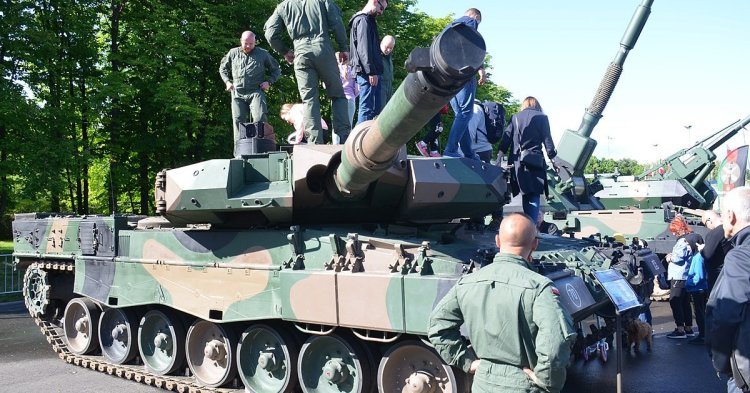On the 1st of November, the famous British newspaper, The Times, claimed that Germany seriously considered giving up the Future Combat Air system (FCAS) in collaboration with its neighbor France and Spain. The FCAS, presented as the next high-technological plane, is slated to replace the French fleet of Rafale and the German’s Eurofighter fleet. Even if the German chancellor, Olaf Scholz quickly denied the Times statement by reasserting its government willingness to participate in the project, the rumor illustrates clearly the difficulty for European countries to build a strong European defense industry.
European countries: between competition and association
The two biggest powers in the European Union, France and Germany, and their collaboration in defense industries shed light on the challenges that face European countries in building a strong and well-organized defense industry. France and Germany started their cooperation to reduce cost of production and share their best defense technology. Three projects represent this goal. Firstly the Main Ground Combat System (MGCS) project launched in 2012 to replace the French tank “Leclerc” and the German “Leopard 2”. Then the FCAS and finally the Maritime Airborne Warfare system (MAWS) started in 2018 but terminated three years later. The MGCS and FCAS project advance slowly due to a lack of political support but above all, they imply high-technologies pooling dependent on national sovereignty.
The French-German couple is a microcosm of the situation. The FCAS faces a challenger, the Tempest project which includes the United-Kingdom, Sweden and Italy. Further, there are three combat aircraft which compete with each other: the French Rafale, the Swedish Gripen and the Eurofighter built through an alliance of the United Kingdom, Germany, Italy and Spain. Combat helicopters are also a field of intense competition with Airbus helicopters and the Italian Augusta-Westland as relevant candidates. Moreover, European manufacturers must contend with the aggressive policy of American manufacturers. According to specialists, the American F-35 aircraft will represent half of the combat aircraft in Europe in ten years. The Lockheed Martin planes have been selected numerous times in Europe in the last ten years in countries such as Norway, United-Kingdom, Germany, Switzerland, Poland, Belgium, and more.
Due to the small size of their national market, European industries are forced to export to maintain their activities. It creates jobs while countries use armament exportation to build ties with other countries, facilitating cooperation. A powerful defense industry gives economic and diplomatic advantages. That’s why it is difficult for European countries to give up their national industries to establish a supranational project. According to the Stockholm International Peace and Research Institute (SIPRI), there are five European countries in the top ten defense exportations: France, Italy, Germany, United-Kingdom, and Spain. In the 90s, the collapse of the USSR and the evolution in military doctrine impacted dramatically the defense market. The new military requirements pushed companies to merge which gave rise to massive firms in the US. They successfully entered the European market while the contrary process (European defense firms entering the US market) did not happen. Owning high-level technologies, supported by a strong government diplomacy, and helped by the presence of NATO, US companies give a fierce competition to European industry.
What’s next?
However, the competition should not make us forget that some projects managed by European countries used to achieve results. The Tornado aircraft is the result of a collaboration between the United Kingdom, Germany and Italy. Also, the Eurofighter is a model to follow. In the 90’s and 00’s, European industries from different countries closely cooperated. Before being bought by Leonardo, the helicopter company Agusta-Westland was a collaboration between Italian and British. In 2015, the project KANT gave birth to KNVD, a firm specialized in land armaments. Airbus and its armament branches, Airbus Defense & Space and Airbus helicopters supply Europeans armies with helicopters and transporters. The missile manufacturer, MBDA was born out of an association between Airbus, French, British and Italian companies. It is a success story. This is evident by MBDA being the largest seller in Europe and the second largest in the world. Also, the Eurodrone which gathers Airbus, Dassault Aviation and Leonardo is expected to enter service in 2028. France, Italy, Germany and Spain have already placed orders.
The birth of a strong European defense industry is closely related to the European security vision. From such a perspective, the French-German couple precisely illustrate the disputes. On one side, France hammers the necessity for Europe to maintain distance from NATO to build an independent third way power interleaved between the US and China. On the side, Germany does not reject the idea defended by France but prefers to organize European security through NATO. Even if these differences slow down negotiations or political projects, Europe and the EU possess agencies and institutions that can be explored further. Europe has set up institutions and agencies to ensure cooperation between industries. The Organization for Joint Armament Cooperation (OCCAR) coordinates armaments programs between European countries. The European Union has set up the European Defense Agency (EDA) to support European defense projects. These two bodies are contributing to the development of the Eurodrone, Finally, the European Defense Fund (EDF) supports transnational projects bringing together three industries from three different countries. It has a budget of 8 billion euros.
The creation of a European defense industry is not simply a matter of industrial cooperation but also of a political project, the outcomes of which are still impossible to define.


Follow the comments: |
|
